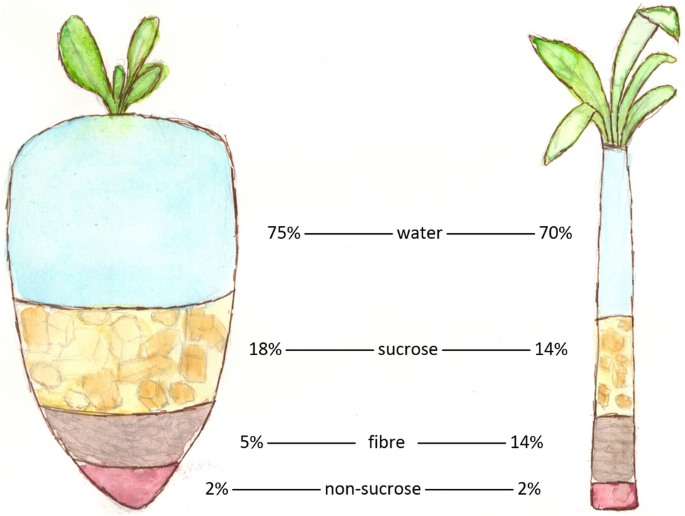Discover the Uses and Benefits of Beet Sugar Vs Cane Sugar in Your Daily Diet Regimen
Checking out the unique high qualities of beet and cane sugar discloses more than simply their sweetening capacities; it highlights their unique effect on wellness and culinary arts. Beet sugar, recognized for its refined taste, is commonly preferred in fragile treats, whereas cane sugar, with its hint of molasses, includes splendor to robust recipes. Each type holds its own dietary account and glycemic ramifications, welcoming a deeper understanding of their roles in a balanced diet plan and lasting usage techniques.
Beginning and Manufacturing Processes of Beet and Cane Sugar

The distinctive environments and dirt kinds required for growing sugar beetroots and sugarcane add to distinctions in their cultivation practices and geographic circulation, affecting the business economics and sustainability of their production. beet sugar vs cane sugar.
Nutritional Contrast Between Beet Sugar and Cane Sugar
Regardless of stemming from various plants, beet sugar and cane sugar are nutritionally really comparable, both primarily containing sucrose. Each gives concerning 4 calories per gram, translating to approximately 16 calories per tsp. Structurally, both sugars are composed of approximately 99.95% sucrose, with marginal quantities of various other materials like dampness and trace minerals, which do not dramatically modify their nutritional accounts.

Eventually, when picking in between beet sugar and cane sugar based on nutritional content alone, both deal identical benefits and downsides as they are basically forms of the exact same molecule-- sucrose, giving quick power without various other nutrients.
Influence On Health: Glycemic Index and Caloric Content
Discovering better right into the results of beet sugar and cane sugar on wellness, it is necessary to consider their glycemic index and calorie content. Both sugars are classified as sucrose, which contains glucose and fructose. This composition leads them to have a similar influence on blood glucose levels. The glycemic index (GI) of both beet and cane sugar is around 65, categorizing them as high-GI foods, which can create fast spikes in blood sugar degrees. This is an important aspect for people taking care of diabetic issues or those trying to stabilize their energy levels throughout the day.
Each type of sugar contains around 4 calories per gram, making their caloric content matching. For those monitoring caloric consumption, particularly when handling weight or metabolic health problems, comprehending this equivalence is crucial (beet sugar vs cane sugar). Too much consumption of any type of description high-calorie, high-GI food can add to health and wellness concerns such as weight problems, heart condition, and insulin resistance.
Environmental and Economic Considerations of Sugar Manufacturing
Beyond wellness impacts, the production of beet and cane sugar likewise elevates substantial ecological and financial problems. Sugar beet cultivation often tends to need cooler climates and has a reduced geographical footprint contrasted to sugar cane, which thrives in exotic regions. However, both crops are intensive in regards to water use and land occupation, potentially leading to logging and water deficiency. Economically, the international sugar market is extremely volatile, influenced by changes in global trade plans and aids. Lots of nations incentivize sugar manufacturing with financial backing, skewing market prices and impacting small-scale farmers adversely.
In addition, making use of pesticides and fertilizers in both beet and cane sugar cultivation can bring about soil destruction and contamination, additional affecting biodiversity and neighborhood water bodies (beet sugar vs cane sugar). The choice between cultivating sugar beet or cane usually pivots on neighborhood environmental problems and financial variables, making the sustainability of sugar production an intricate website link concern
Culinary Applications and Flavor Differences
While the environmental and financial facets of sugar manufacturing are undoubtedly substantial, the option between beet and cane sugar likewise affects culinary applications and flavor profiles. Beet sugar, originated from the sugar beet plant, is recognized for its extremely neutral preference. This makes it a flexible active ingredient in baking, where it does not change the taste of other components. It dissolves promptly and is perfect for use in cakes, cookies, and breads.
Walking cane sugar, extracted from sugarcane, frequently maintains molasses traces, which pass on a distinct splendor and depth. This small molasses flavor enhances the complexity of baked items, sauces, and sauces. It is especially preferred in products where a sugar touch is wanted, such as in brownies or gingerbread. In addition, the mild variation in wetness web content in between beet and cane sugar can influence the structure and uniformity of her comment is here dishes, making cane sugar a favored choice for certain dishes that take advantage of its distinct buildings.

Conclusion
Finally, both beet and cane sugar have distinctive origins and production processes, using similar dietary profiles with slight distinctions in salt material and taste. While their effect on health, particularly relating to glycemic index and calories, is equivalent, the option in between them commonly comes down to environmental, financial elements, and details culinary needs. Comprehending these facets can assist customers in making educated choices that align with their wellness objectives and taste choices.